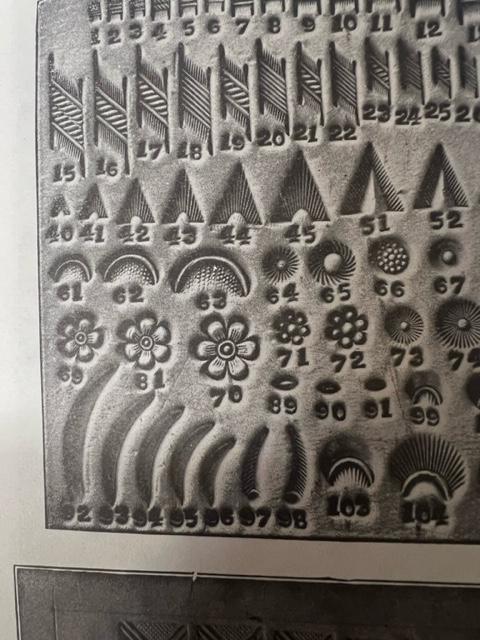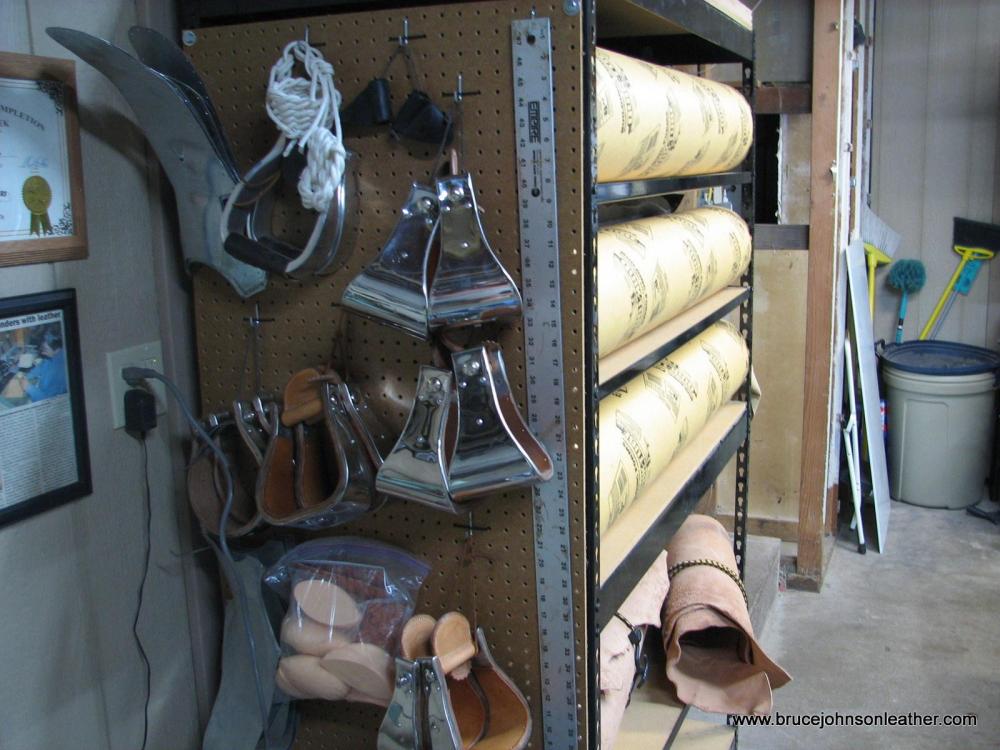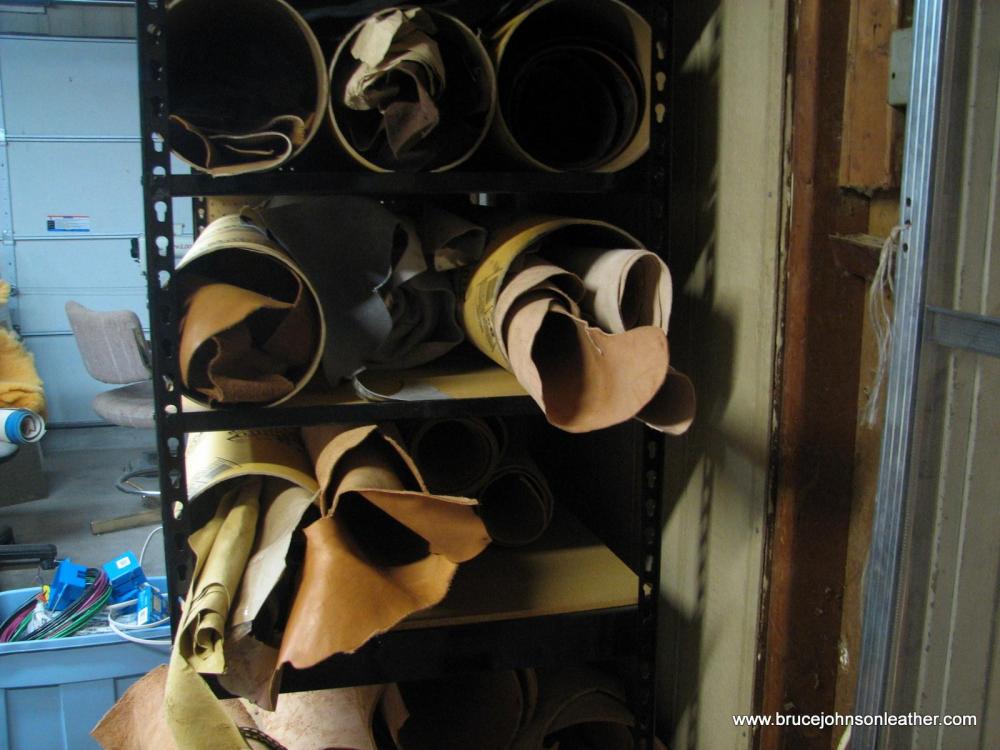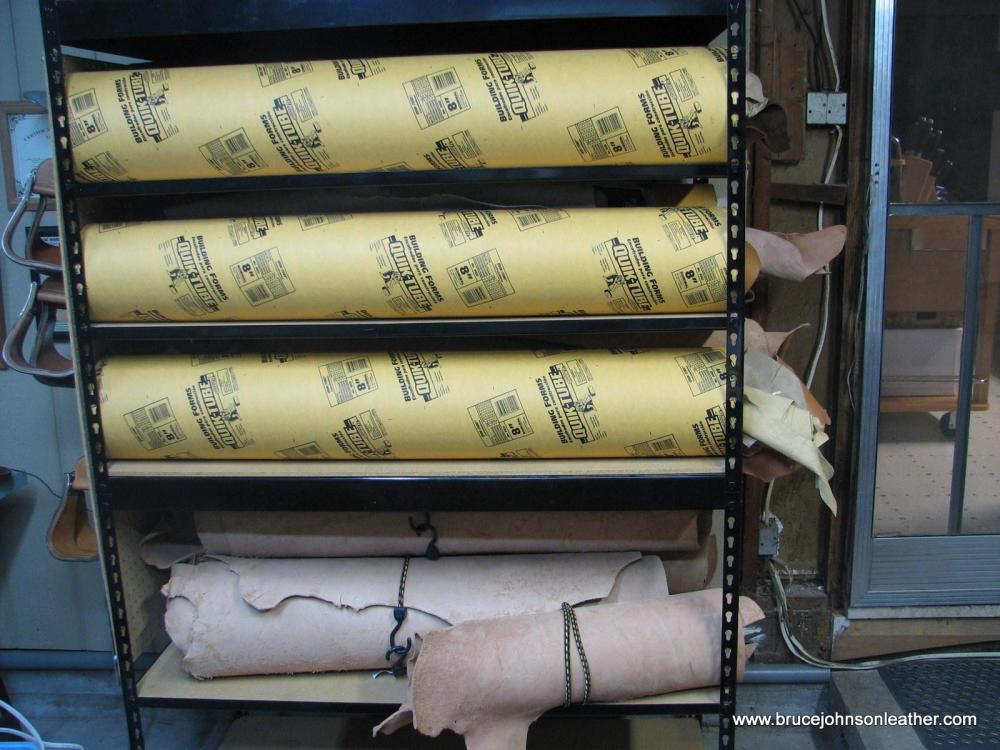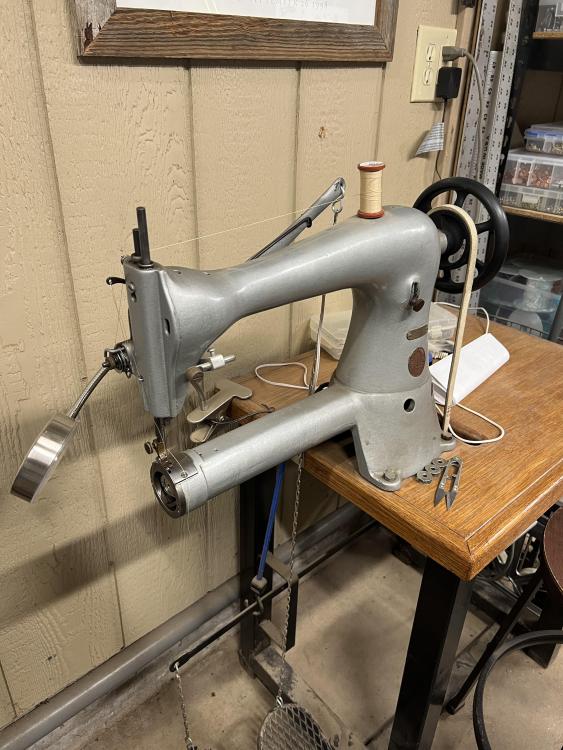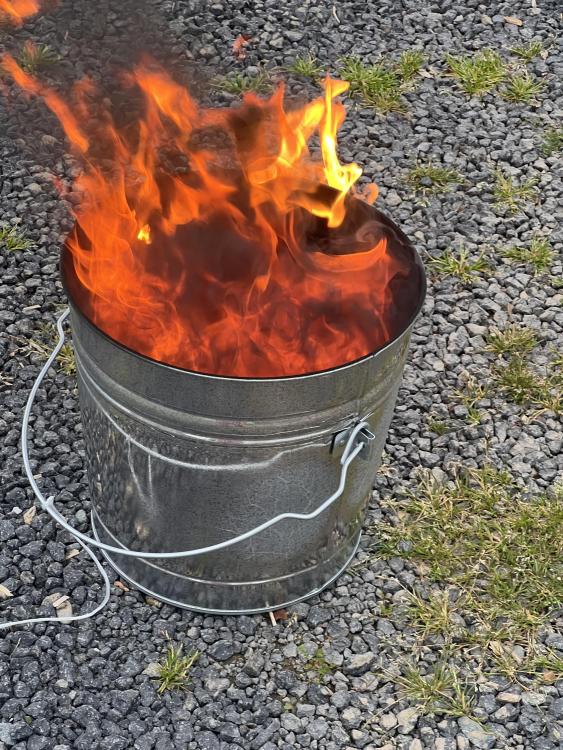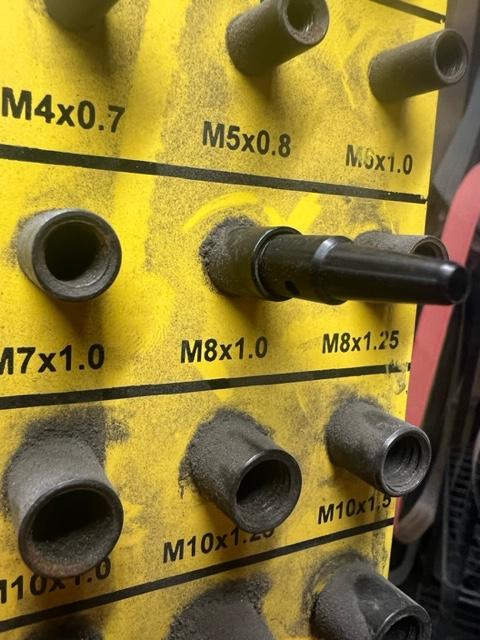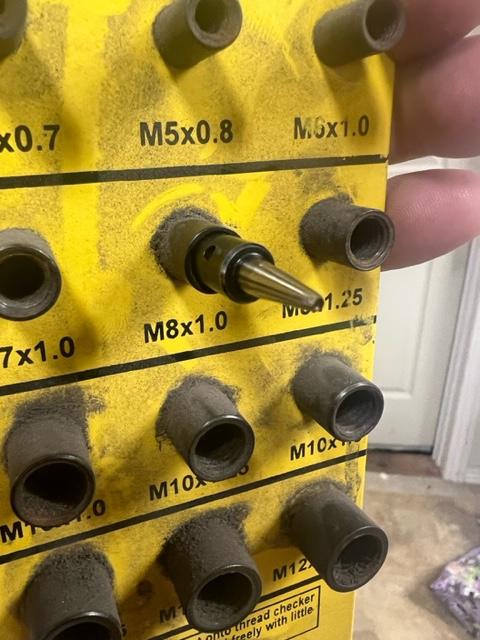-
Posts
4,372 -
Joined
-
Last visited
Content Type
Profiles
Forums
Events
Blogs
Gallery
Everything posted by bruce johnson
-
When you are looking realize that size numbers mean very little from one maker to the next. The older system for the Osbornes and Gomph was each number on edgers was 1/16” of cut. The newer ones (within the last 40 years) don’t correlate with other makers size numbers.
-
Totally agree with Bob. Limited in what they can do, marks up the back side. I bought one from Ron (Ferdco in Idaho) when the 440s were advertised in horse and tack magazines for $1500. Anything else new that stitched leather was $5000 or more at that time. I had it a day and realized that the mechanics of it was not the machine for me. Ron offered me a used Adler 205-64 head as a replacement and we swapped heads for "$1000 - I'll hold the check and you tell me when to cash it". Best deal I could have done, they really helped me out when I needed it! The Adler was bullet proof and made me a lot of money. Not a fan of the 440 for good stuff. I know people who sew production belting stuff and replacement tack parts on them, but finer stuff was just not passable for me.
-
I checked and sorry but don't have either for sale or coming up for sale, just the 6 petal in a few sizes in my personal set. You could expect to pay $75-100 for them when they come up. I sold a few of the six petals at the Sheridan show for $90. These good old McMillens don't come up like they used to. The 6 petal stamp is a little more common than the dots stamp. They haven't made any stamps for several years with no plans to start stamps again.
-
Butt leather is the firmest part of the hide to start with. Belting leather may also have been compressed to remove some stretch. There is not as much flex to that butt part of the hide because it is tighter. It is an advantage for some things and disadvantage for others. Making a sharp bend or fold in it can sure split the grain. Best leather and any leather that has been compressed (aka "jacked") is more prone to cracking when folded there. The firmer flesh part will not compress as easily as lower side, shoulder, or neck sections when folding. When you fold it this makes more tension on the grain portion of the thickness and can lead to the cross splitting. One trick is to soften that area with warm water prior to folding to somewhat case it.
-
Top one could be a McMillen, especially if the holster is old. I’ve probably got it. Bottom is mcMillen. Like in 81 or 70 and 72in the old McMillen catalog
-
I have had zero problems with anything in these tubes - chrome tan, veg tan, or oiltan. Some of the chrome tan leather we pick up on specials at shows sits for a few years before it is used up now with no problems. These tubes are durable and most are still the originals from at least 17 or 18 years ago. She has replaced a few bigger tubes with more smaller ones now since she uses more chrome tan than I did.
-

Grain Or Flesh, Which Is Stronger?
bruce johnson replied to TomE's topic in Leatherwork Conversation
Yes I think the grain side generally has more tensile strength. If it didn't we would be using splits to make good lace. That said, some tannages of splits carry some good strength like pearl apron splits for aprons and horn wraps. My opinion on grooving is just this - my opinion. I am a groover, I have stickers on my sewing machines to remind people who use them to groove. First and foremost it gives you a visual target to stitch in. Edge guides on machines are nice but not foolproof. You can have the nicest machine - dialed in with the prefect thread and needle combination and tensions just right. Make one wiggle in the line and it is like a zit on the prom queen's nose. You see it first and last. People who say grooving weakens the leather - here's your test. Groove off a section and pick up that little leather thread that you just grooved off. Pinch it between your fingers on each hand and pull. Pretty flimsy and about zero tensile strength. It is not taking away anything from the strength of your leather and likewise leaving isn't adding anything. Edger trimmings have more strength and we edge our leather religiously. -
Here's how I did it 15 years ago and my wife does now. The 4 foot long Gorilla racks hold the Sonotubes perfectly. Chap and latigo are sorted by color and type so they don't bleed on each other. lighter weight Vegtan same thing. I was pretty busy then and I went through 5 side or 10 side skirting sides fast enough they never marked from light exposure. They were just rolled loosely and secured with a bungee. One of these 6 foot high shelving units can hold a lot of rolled leather with easy access. Ignore the open wiring in the background. This was during a shop upgrade and the electrician was replacing the DIY job the previous owners had done.
-
The brass handled ones are beautiful. Until the later 1800s they were all brass and wood handles. I've got one going back to the 1830s very similar except no trigger. The triggers were a late 1860s addition. I've got a couple showpiece kind of plough gauges that were my daily users also. I like pretty tools.
-
There are a lot of ways to cut straps but not many are stronger or prettier than these 100+ year old draw gauges. These are among my favorite tools to refurbish for sure. Somewhere along the line we changed from function and beauty to ease of manufacture and price point on a lot of tools. I'd bet the old guys that owned these oldies first were pretty proud when they got them and I always hope I've honored them.
-
Welcome back Shirley!! Some of us originals are still around
-
As mentioned tannage can play a part and everyone wants to blame tanners in 3rd world countries that use urea or urine. Maybe some still do but some of the chemicals and bark sources are similar and can give that odor. If it is truly cat pee and pretty well permeated into the leather, you can spend time and materials to clean it with maybe so-so results. You can consider the time involved and toss it to use something fresh that you and ultimately customers wont find offensive. 10-40 year leather is harder to work generally unless it has been stored really well. Smelling like cat pee tells me it hasn't. I've been to shops where the shop cat(s) are not the most litter box trained beast. Eventually everything catches that odor - tools, boxes, packing material besides leather. I have had packages from one place intercepted and inspected because they smelled of urine and drug inspection dogs hit on them - just like smuggling drugs and trying to mask it with coffee.
-
I am now stocking the 1-1/4 inch CS Osborne punches in round end and English point versions. I am not sure why I wasn't before but I have rectified that faux pas today. This pretty much fills the strap end punch lineup now from 1/4 inch through 2 inch. As with all the new Osborne tools I sell, the punches come sharp and ready to use. All sizes are currently in stock and ready to ship. Please check them out at https://brucejohnsonleather.com/leather-tools-sale/new-cs-osborne-leather-tools-sale/ Thank you! - Bruce
-
Dye the background with dye and a brush. Some people are handy enough to use a syringe and small needle, some use refillable dye pens. Not really a new thing but some makers dye the sides and background, basically everything but what is tooled. Lots of stuff out there like that now. Google JD Filho, Joey Jemison, Travis Stillson for some good examples of that. There are a ton more but those folks will get a start for examples.
-
Simple and easy to identify from a distance. We live in an area that still has some big remote pastures and forest service leases. cattle can get through fences onto the neighbors. Being able to sort these cattle on horseback and get them back through is easier than driving them to a corral and sorting by tags that may be lost or tattoos. Cattle get brand inspections when transported very far or sold to prove ownership. Some will get rebranded if they are going to be turned out. Hides are a byproduct and obvious proof of ownership is more important to the producer than hide damage that may or may not be docked for at sale time. Packers that buy western origin beef cattle expect brands and that is just a fact of their business.
-
I like the prelubricated thread also. For most work I did not need to use the thread lube pot on the Ferdco 2000. It is kind of a pain to set up and fish the top thread through the guides and strippers. Where I did use it was on production straight run stuff. I made a bunch of doubled and stitched latigo reins for contract and also my own sales. Basically set the guide and let 'er rip with the servo wide open for 7 feet across the end and another 7 feet of pedal to the floor. Smoke would come off the needle and thread would get "sticky" and skip if I didn't lube. Sewing machine people told me the lube is more for heat reduction and lubricating the needle than actually lubing the thread and that made sense to me. I used Sellari's, Lily, and at times even Lexol conditioner as thread lube and not much difference I could see. I was in one shop that ran wide open. He set his spools in coffee cans and the thread ran off them from inside the can. He squirted the new spools with oil pretty heavy to start and then every so often as the spool went down. The wax pots are heated and the thread goes through melted wax. As it cools the wax hardens and helps lock the thread and seals the hole. Pick some petrified stitches on some old saddle skirts and you will understand.
-
Just to be clear. Are you talking about a hard wax or thread lube? Reason being that many people actually mean the liquid thread lube pots that still get called wax pots. The old timers refer to a wax pot as a pot that heats (gas jet or electric) and melts wax into the thread. Thread lube is a liquid lube like Sellari's, Lily, or silicon.
-

Move along and save or maybe take a risk
bruce johnson replied to Webicons's topic in Leather Sewing Machines
Look fairly similar to my 17-1 except for the press foot. I like this machine a lot. My wife sews wallet interiors and thinner work like that on it. Pretty bullet proof. -

marketing Features vs Benefits
bruce johnson replied to Leatherinspire's topic in Marketing and Advertising
Thank you for the tips. The actual business aspect of pricing and selling is hard for a lot of people and most artists and craftspeople start with minimal business training and marketing experience. It was for me and I'd have loved to have gotten more training than I did. I got more than many people through a small business mentorship program, classes, and books. The internet has changed and a lot of what I had to go someplace and sit through is now on a screen and often for free or minimal cost. People don't have to follow everything you read or hear literally but I have found some the marketing and business concepts are pretty universal. I appreciate the efforts.- 4 replies
-
- selling
- advertising
- (and 5 more)
-

Spontaneous Combustion and Safety With Chemicals
bruce johnson replied to Sheilajeanne's topic in Leatherwork Conversation
Yes oily rags catch fire. I use BLO, mineral spirits, wood finishes, waxes, and solvents galore. Everybody has some tip - lay them out flat, soak them in water, sprinkle them with salt, etc to keep them from catching fire. I’ve got a better method. I beat them to the punch and just burn them myself at the end of the day. Just light them up. It’s not like they are going to be hazard or anything after that. You probably don’t want to cook hotdogs or make S’mores over that fire but works for me. -
The real beauty is in the use! I am glad it got used. Leatherwork can and should be artistic for sure, but being put to use is where the joy is for most of us as a maker. My grandmother was a quilt maker and understood this. I made Grammy a leather magazine can for her garden magazines. She put her sewing stuff in it instead. When she moved to the rest home she used it to hide her contraband jars of dried beef at the bottom under quilting squares. Looks like your mother-in-law's pens and paperclips fit just fine and had a nice home too!
-
I have heard them called a "plonky" in some other countries. I like to say "plonky".
- 12 replies
-
- dividers
- brucejohnsonleather
-
(and 6 more)
Tagged with:
-
Looks great!
-
Threads on the tube that doesn't fit appear they aren't cut deep enough. When I talk about old CS Osborne frames and tubes, I'm going back to some of the Newark marked frames and maybe 30 years after. Anything in the last several decades all are taller threads. You got a dud tube. It will be interesting to see what they say. Probably grab a new tube and send it on. The threads that work on these 00-7 sizes is a M8-1.0 metric tap and die. I've had people tell me that is BS and have several reasons why these #00-#7 threads are not metric. They cite some SAE die on the tube or tap on the frame that somebody else told them. I stopped arguing it online years ago. Here are pictures of new CS Osborne #00 and #3 tubes screwed into the thread checker board in my shop. Chase the threads in a 120 year old frame these new tubes screw right in and bottom out where they are supposed to. You can screw 120 year old tubes into newer frames without anything but I don't trust old tubes off a Newark marked frame. Easier to just unscrew and toss them and put new ones on.
-
It is not the threads on the new tube that are the problem, it is the threads on the old frame. The old dies and tube threads had a lower thread height, same pitch. Run a modern tap through the old frame and the new tubes screw right in. Three different tap sizes. Zeros through #7 have the same size tap. #8 tube is unique to that size only, and #9 and #10 use the same pitch. As far as polishing your tubes….make a steel wool Q-tip. Start with coarse steel wool. With a variable speed drill and small bit. String out some steel wool and wind it on lol the slowly spinning bit. When you’ve got enough of a wad on the bit tear it loose from the string. Shoot a little WD40 on it. From the threaded end slowly spin it through the tube to the tip back and forth a few times. Go to a medium steel wool and repeat. That’ll do it. I will be interested to see what thread pitches they tell you. It isn’t what you think.



